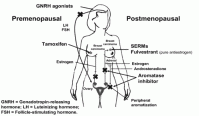Optimizing the Antihormonal Treatment and Prevention of Breast Cancer
Estrogen plays a key role in the development and proliferation of milk glands in the breast.
Until recently, it was generally accepted that estrogen does not directly cause breast cancer. However, recent laboratory studies indicate that estrogen has an oncogenic action in breast cells18, 19).
Nevertheless, because of the strong signal that estrogen has on mediators of the cell cycle, cells that have oncogenic mutations may continue to divide in the presence of estrogen20). Eventually, these cells develop into a palpable tumor. For patients who have ER positive breast cancer, there are important therapeutic options a clinician can implement based on the well developed strategy of anti-estrogenic therapy.
 Fig 1. The sites of action of various classes of endocrine agents used to treat ER positive breast cancer. SERMs such as tamoxifen and toremifene inhibit breast cancer cell proliferation and act as antagonists in the breast. Aromatase inhibitors block the aromatization of androstenedione into estradiol in peripheral tissues, hence preventing production of estrogen. GNRH agonists such as goserelin prevent release of luteinizing hormone and thus inhibit the activation of estrogen production in the ovary. Fulvestrant destroys the ER in breast cancer cells and prevents ER mediated cell replication.
Fig 1. The sites of action of various classes of endocrine agents used to treat ER positive breast cancer. SERMs such as tamoxifen and toremifene inhibit breast cancer cell proliferation and act as antagonists in the breast. Aromatase inhibitors block the aromatization of androstenedione into estradiol in peripheral tissues, hence preventing production of estrogen. GNRH agonists such as goserelin prevent release of luteinizing hormone and thus inhibit the activation of estrogen production in the ovary. Fulvestrant destroys the ER in breast cancer cells and prevents ER mediated cell replication.
The intent of antihormonal therapy in women is based upon blocking the ER signal transduction pathway or inhibiting the synthesis of estrogen (Fig 1).
One option is to use selective estrogen receptor modulators (SERMs) that block the ER and stop breast cancer growth. Tamoxifen, the prototypical SERM, exerts its effect by binding to the ER receptor and altering the conformation of the complex, thereby inhibiting signal transduction cascades that stimulate cell replication.
Unfortunately, tamoxifen expresses its SERM action by promoting cell replication in endometrial cancer cells. This is an estrogen like action that results in a small but significant increase in the detection of endometrial cancer during long term adjuvant therapy or when used in chemoprevention. Nevertheless, it is important to stress that the increase in endometrial cancer noted with tamoxifen only occurs in postmenopausal women21, 22).
Tamoxifen remains the treatment of choice for premenopausal patients.
An alternative to SERMs is to block the synthesis of estrogen in the body with an aromatase inhibitor. Anastrazole, letrozole, and exemestane have all been shown to be effective in treating advanced breast cancer in postmenopausal women. These drugs inhibit the synthesis of estrogen in peripheral tissues23). It is important to stress that aromatase inhibitors should not be used in premenopausal women because ovarian estrogen production may resume through feedback mechanisms24). Finally, another option for hormonal therapy in post-menopausal women with advanced breast cancer and recurrent cancer is to use an ER down-regulator called fulvestrant.
Fulvestrant is administered as a monthly injection to provide a slow, continuous release of the drug to the patient. The active drug binds to and alters the shape of the ER in the tumor cell. The peculiar shape of the fulvestrant-ER complex then results in the rapid destruction of the ER.
As a result of the destruction of the ER signal transduction pathway, fulvestrant has no agonist activity on the ER25).
An antihormonal option for premenopausal women is the long acting gonadotropin releasing hormone, goserelin.
The sustained release of goserelin from the implantation of a rice grain sized depot lasts for one month and desensitizes the hypothalamic-pituitary axis to produce the equivalent of a medical oophorectomy26).
In this paper, we will discuss the agents currently available in the United States to treat ER positive breast cancer. We will first discuss the use of antihormonal agents to treat metastatic breast cancer. This will serve as a basis for our discussion of current adjuvant therapies and recent results of chemoprevention studies.